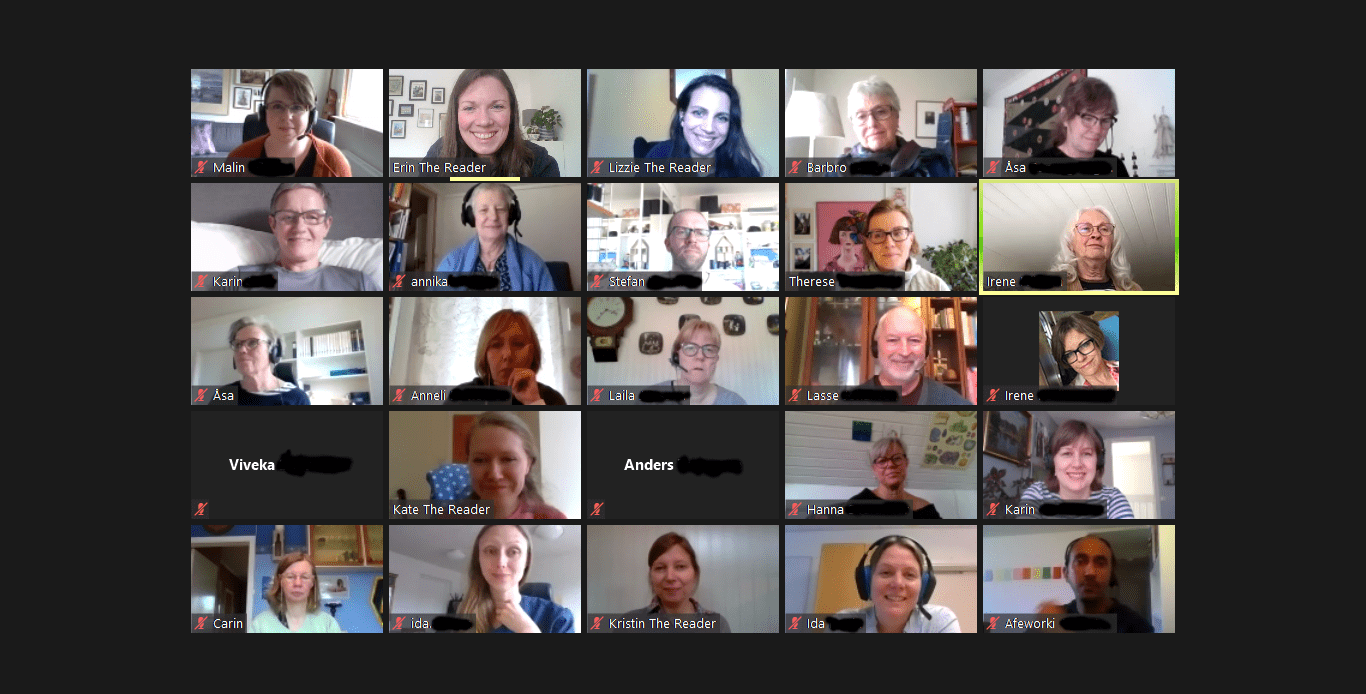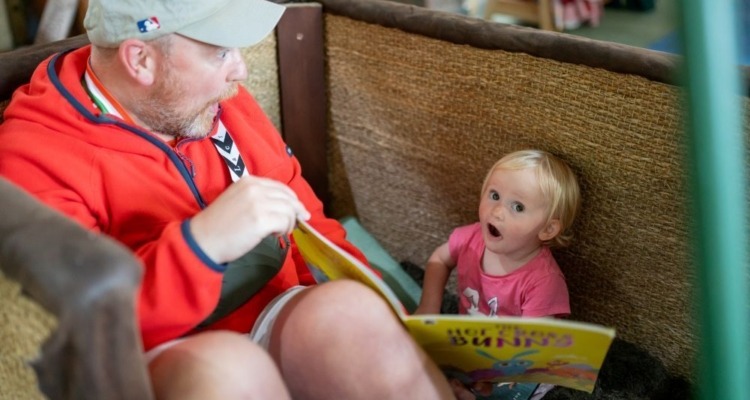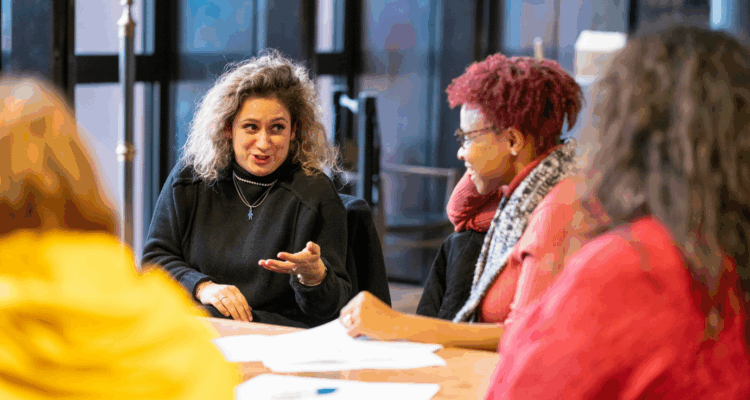Read To Lead’s Online Swedish Adventure
While we’re no strangers to delivering Shared Reading training to international participants here at The Reader, we’ve usually done so in-person, packing off our Teaching and Learning Leaders to destinations ranging from Belgium, Brazil, Germany and Australia. 2021 represents another landmark in bringing the Reading Revolution worldwide – the first delivery of the online version of our Read to Lead training to participants outside of the UK.
Kristin Hutchinson, Teaching and Learning Leader, reports on the first of what we hope will be many of these online international courses.

On the morning of 1 March, a team of four of us gathered to settle ourselves before embarking on the first online International Read to Lead training to be delivered to Värmland, an area of Northern Sweden. There were some inevitable anticipatory nerves. Because of the size of the cohort it was decided to split into two cohorts of twelve, so as to give them a better chance of supporting each other and to give us more idea of how to support them individually.
There were other practical considerations – Sweden is one hour ahead of us so we had to rethink break times, especially as ‘fika’ is an important ritual for Swedish people. Often translated as coffee and cake, it is a lot more than that – a pause to refresh the mind and body and importantly something to enjoy with other people, family and/or friends. This feels like something very in tune with The Reader, though under Covid conditions ‘fika’ often has to be taken alone.
So we began, with many silent questions in our heads – what would the group be like? What would their English be like? How would the Shared Reading model be received? During Module 1 we had to learn about each other fast, but the depth of engagement was obvious from the first. As Kate, who was leading our cohort reflected later,
‘the passion, enthusiasm and commitment of our Swedish trainees was wonderful to behold!’
In the group reflections after their first immersion in Shared Reading, a range of responses came up – the experience felt ‘relaxing/calming/scary’; one felt the ‘pressure to be wise’, another ‘the pressure of technology’; one said that it ‘opens the book for me’; another that ‘it was nice to just have permission to listen’. Often at this point in the course trainees mention the slowness in the pace of reading aloud, with much thinking and discussion about how different this feels to previous encounters with literature. In our cohort, we could feel something else going on, which, in our debrief afterwards, we identified as possibly an anxiety that we were going slowly because the Varmland participants were learning in a second language. Kate spoke to this in Module 2 and they confirmed it had been a concern. Afterwards everything felt more settled and the slowness could take its proper place.
Something else that we had to attune to as the training went on was that although all the trainees spoke brilliant English (which cannot be said of our Swedish!), as Kate said ‘some of their thoughts and questions were articulated in a more direct way than we are used to, which proved to be challenging until we adjusted to a different way of being and speaking’. As someone who was carrying much less responsibility than Kate, I found this refreshing, as my experience of other types of online groups has been that something about the ‘online-ness’ often seems to make groups drift towards consensus and lose out on important areas of thinking as a result. Maybe it’s a cultural difference – certainly this honest directness seemed to translate into their responses to the literature itself. As Lizzie (supporting the other cohort) articulated - they seemed
‘very comfortable with the idea that someone could have a strong emotional response to the text and that’s okay, they wouldn’t shy away from it’.
This was also the case with disagreement among themselves as a group. As Lizzie put it, they were skilled at ‘holding space for the individual needs of each group member’ – being bold in direct and quiet ways was not a problem for them.
We noticed that when we broke into breakout rooms, the participants were more relaxed, as often happens, but they also broke into speaking Swedish and English. One of our cohort named this for us as an example of ‘translanguaging’, a way of using all the languages in the group, especially where there are bilinguals, for ease of communication when working things out. This was new to me, but what is remarkable about it as a language teaching tool is how closely it aligns with the core idea of Shared Reading – using language and, by extension, literature for the purposes of communication and thinking, over any idea of ‘getting it right’.
So who were these wonderful trainees? A huge mixture as you would expect – librarians, one with a travel service called Come to the Book; teachers; an ex-actress reading poetry with young people; a games master facilitating role-play games with vulnerable young people; a creative writing teacher; a professor at Karlstad University wanting to read with women to build increased intercultural awareness; a Red Cross volunteer; a curator; a freelance journalist; a deacon from the Church of Sweden working with the local library and health centre; an author working with City Mission to help people in isolation and an international coordinator in education and sustainable development. I wonder if their social mindedness connects to the Swedish idea of ‘folkbildning’, which was partly the motivation for them doing Read to Lead. ‘Bildning’ means learning so it can be loosely translated as popular education, the Swedish form of non-formal adult education. Funded by the state since 1912, the importance of folkbildning as part of civil Swedish society is recognized by all political parties. Its cornerstone is the idea of ‘the study circle,’ which interestingly, overlaps to a degree with Shared Reading’s theory of change – both emphasize ‘the shared’ in shared learning. I wonder if this cultural background was partly what explained the level of commitment of our trainees, and perhaps their ease with our style of teaching – it felt very affirming when one of our trainees said ‘I like this pedagogy’.
I think Lizzie spoke for all of us when she said, ‘Overall, this was a really hard, great cohort – hard in the good way. Their questions and the debrief sections made me a better trainer and challenged me to deliver the course to a higher standard’. This was echoed by one of the trainees in Module 5 who said they were ‘the good kind of exhausted’. A couple of the different questions they asked were, for example, about the difference between Shared Reading and bibliotherapy, (apparently bibliotherapy is quite big in Sweden), and whether Shared Reading has been tried with autistic groups. One trainee expressed slight frustration that so little of the literature offered by The Reader in its anthologies, especially the poems, had been translated into Swedish. Food for thought!
Because of the way the course had been planned, there was quite a gap between Modules 5 and 6, which meant some of the learning momentum was lost, but it was great to join together in one large cohort to finish with and feel, as Erin said,
‘part of the larger Shared Reading community all together’.
This included, on the Swedish side, Asa, Irene and Stefan from Region Värmland – the commissioners of the training - at this point to give valuable local advice and support for the next steps. For me, the end of Module 5 felt very emotional, as I led this one by myself and had to say goodbye to our cohort. The warmth was overwhelming and they particularly loved the reminder ‘to smell the roses’ in the Five Tips part of ‘where to pause’.
I will always remember this, my first experience of helping deliver Read to Lead, as well as the first online international delivery. Such is the nature of shared reading, as Kate said, that ‘it soon felt we had all grown to understand each other well’. It was such a privilege to get a glimpse into the lives of our trainees, including regular guest-starring cat appearances! Small things that stay with me – one trainee talking about Penelope Shuttle’s poem ‘Outgrown’ saying ‘it hits me in my bones’; another doing her poem practice with Charlotte Mew’s ‘The Call’, stopping to listen as she and we heard the snow being cleared outside her door. It was wonderful to have this kind of intimacy online! Also, to see the group go quiet as the idea of Shared Reading began to be taken in, and breakthrough moments such as when one trainee said, ‘it’s not your own performance but about the group’ felt very special.
I am in awe of my fellow trainers, Erin, Kate and Lizzie and feel so lucky to be able to learn from them. Thanks to them too for contributing their thoughts and reflections.
Kate sums it up well when she says,
‘All in all, it was a wonderful experience that really showed the far-reaching magic of Shared Reading; transcending nation and culture to unify people, even during a pandemic. There was even talk of a Reader trip to Sweden and a Swedish visit to Calderstones!’
We can’t wait to hear what our trainees go on to do and big thanks to them too for being such a committed part of our first online international Read to Lead delivery. Skål!
If you or someone you know would like to take part in our transformative training course 'Read to Lead' submit an enquiry here.
Share
Related Articles

We cannot just tell parents to read more. To truly improve children’s futures through reading, we need to properly support the adults around them to do so.
Responding to the Department of Education's announcement that 2026 will be a Year of Reading, The Reader's Managing Director Jemma…

Shared Reading in Wirral Libraries: ‘As a kid people read stories to you but as an adult you lose that – and it’s a fantastic thing to do!’
Two Strategic Librarians for Wirral Libraries, Kathleen McKean and Diane Mitchell have been working in partnership with the UK’s largest…

Pat: ‘You don’t need to be an academic – it’s about going on your gut feeling about a story or poem’
National charity The Reader runs two popular weekly 90-minute Shared Reading group at one of the UK’s most innovative libraries,…


